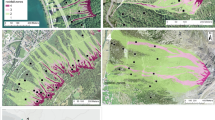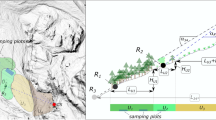Abstract
• Context
One eighth of Europe’s forests are still managed as coppice. In some European countries, more than half of the forest exhibits coppice structures from the past or present coppice management. Many of these forests grow in the broadleaf zone of mountainous regions, often on steep slopes. Here, they play an important role in rockfall protection. However, it remains unclear how coppice forests should be structured for optimal rockfall protection or how the protection effect changes during the aging of the coppice.
• Aim
A few studies have applied rock trajectory analyses, but so far, no process-based model has been used to quantify the protective effect of differently structured coppice forests. The present study compared 40 coppice patches from two chronosequences in South Tyrol, North Italy, regarding their protective effect against rocks of two sizes using the rockfall simulation model Rockyfor3D.
• Results
The results indicate that coppice stands older than 30 years better protect against rockfall than medium-aged and young stands, although the old ones have lower stem densities. Surprisingly, a random stem distribution had a better protective effect than the clumped stem distribution typical for coppice stands.
• Conclusion
Implications for future management are discussed in detail, including the relevance of standards in coppice forests.






Similar content being viewed by others
References
Autonome Provinz Bozen–Südtirol (2010) Waldtypisierung Südtirol, Band 1 & 2. Bozen
Bertrand D, Bourrier F, Olmedo-Manich I, Brun M, Berger F, Limam I (2013) Experimental and numerical dynamic analysis of a live tree stem impacted by a Mouton Charpy’s pendulum. Int J Solids Struct 50:1689–1698
Ciabocco G, Boccia L, Ripa MN (2009) Energy dissipation of rockfalls by coppice structures. Nat Hazards Earth Syst Sci 9:993–1001
Dorren LKA (2012) Rockyfor3D (v4.1) revealed—transparent description of the complete 3D rockfall model. ecorisQ paper
Dorren LKA, Berger F (2005) Stem breakage of trees and energy dissipation during rockfall impacts. Tree Physiol 26:63–71
Dorren LKA, Berger F, Putters US (2006) Real size experiments and 3D simulation of rockfall on forested and non-forested slopes. Nat Hazards Earth Syst Sci 6:145–153
Dorren LKA, Berger F, Jonsson M, Krautblatter M, Mölk M, Stoffel M, Wehrli A (2007) State of the art in rockfall–forest interactions. Schweiz Z Forstwes 158:128–141
Frehner M, Wasser B, Schwitter R (2005) Nachhaltigkeit und Erfolgskontrolle im Schutzwald. Wegleitung für Pflegemassnahmen in Wäldern mit Schutzfunktion
Gerber C, Elsener O (1998) Niederwaldbetrieb im Steinschlaggebiet. Wald Holz 14:8–11
Gsteiger P (1993) Steinschlag Schutzwald. Ein Beitrag zur Abgrenzung, Beurteilung und Bewirtschaftung. Schweiz Z Forstwes 144:115–132
Hartigan JA, Wong MA (1979) A K-means clustering algorithm. Appl Stat 28:100–108
Jancke O (2012) Quantifying the mechanical resistance of coppice trees against rockfall. University of Hamburg, Germany, Dissertation
Jancke O, Dorren LKA, Berger F, Fuhr M, Köhl M (2009) Implications of coppice stand characteristics on the rockfall protection function. For Ecol Manag 259:124–131
Jancke O, Berger F, Dorren LKA (2013) Mechanical resistance of coppice stems derived from full-scale impact tests. Earth Surf Process Landf 38:994–1003
Jonsson MJO (2007) Energy absorption of trees in a rockfall protection forest. Eidgenössische Technische Hochschule, Switzerland, Dissertation
Lambert S, Bourrier F, Toe D (2013) Improving three-dimensional rockfall trajectory simulation codes for assessing the efficiency of protective embankments. Int J Rock Mech Min Sci 60:26–36
Leyer I, Wesche K (2007) Multivariate Statistik in der Ökologie: Eine Einführung. Springer, Berlin
Lundstrom T, Jonsson MJ, Volkwein A, Stoffel M (2009) Reactions and energy absorption of trees subject to rockfall: a detailed assessment using a new experimental method. Tree Physiol 29:345–359
Matula R, Svatek M, Kurova J, Uradnicek L, Kadavy J, Kneifl M (2012) The sprouting ability of the main tree species in Central European coppices: implications for coppice restoration. Eur J For Res 131:1501–1511
Notaro S, Paletto A (2012) The economic valuation of natural hazards in mountain forests: an approach based on the replacement cost method. J For Econ 18:318–328
Oksanen J, Blanchet FG, Kindt R, Legendre P, Minchin PR, O’Hara RB, Simpson GL, Solymos P, Stevens MHH, Wagner H (2012) vegan: community ecology package. R package version 2.0-3
Pelissier R, Goreaud F (2010) ads: spatial point patterns analysis. R package version 1.2-10
Piussi P (2006) Close to nature forestry criteria and coppice management. In: Diaci J (ed) Nature-based forestry in Central Europe: alternatives to industrial forestry and strict preservation, vol 126. Studia Forestalia Slovenia, Slovenia, pp 27–37
Piussi P, Farrell EP (2000) Interactions between society and forest ecosystems: challenges for the near future. For Ecol Manag 132:21–28
Puumalainen J (2001) Structural, compositional and functional aspects of forest biodiversity in Europe (no. ECE/TIM/DP/22). United Nations, Geneva
R Core Team (2012) R: a language and environment for statistical computing. R Foundation for Statistical Computing, Vienna. http://www.R-project.org/. Accessed 22 June 2012
Radtke A, Ambraß S, Zerbe S, Tonon G, Fontana V, Ammer C (2013) Traditional coppice forest management drives the invasion of Ailanthus altissima and Robinia pseudoacacia into deciduous forests. For Ecol Manag 291:308–317
Rozas V, Zas R, Solla A (2009) Spatial structure of deciduous forest stands with contrasting human influence in northwest Spain. Eur J Forest Res 128:273–285
Stokes A, Salin F, Kokutse AD, Berthier S, Jeannin H, Mochan S, Dorren L, Kokutse N, Abd. Ghani M, Fourcaud T (2005) Mechanical resistance of different tree species to rockfall in the French Alps. Plant Soil 278:107–117
Volkwein A, Schellenberg K, Labiouse V, Agliardi F, Berger F, Bourrier F, Dorren LKA, Gerber W, Jaboyedoff M (2011) Rockfall characterisation and structural protection—a review. Nat Hazards Earth Syst Sci 11:2617–2651
Wehrli A, Zingg A, Bugmann H, Huth A (2005) Using a forest patch model to predict the dynamics of stand structure in Swiss mountain forests. For Ecol Manag 205:149–167
Wehrli A, Dorren LKA, Berger F, Zingg A, Schönenberger W, Brang P (2006) Modelling long-term effects of forest dynamics on the protective effect against rockfall. For Snow Landsc Res 80:57–76
Woltjer M, Rammer W, Brauner M, Seidl R, Mohren GMJ, Lexer MJ (2008) Coupling a 3D patch model and a rockfall module to assess rockfall protection in mountain forests. J Environ Manag 87:373–388
Acknowledgments
Special thanks to Theresa Wagner and Joseph Molyneux for their help in the field, to Giustino Tonon and Verena Larcher for their support with the sampling design, and most importantly, to Oliver Jancke for numerous enlightening discussions about rockfall in coppice forests. Thomas Cordonnier gave valuable advice for the spatial analyses of the tree distributions. The study was supported by the forest service of the Autonomous Province of Bolzano. Joseph Bartho corrected the English. We thank Barry Gardiner and one anonymous reviewer for their very valuable comments to improve the manuscript.
Funding
The EcoRAlps project was funded by the Stemmler and Immerschitt foundations within the “Stifterverband für die deutsche Wissenschaft” (Association of Foundations for German Science) and the Foundation of the Free University of Bozen-Bolzano.
Author information
Authors and Affiliations
Corresponding author
Additional information
Handling Editor: Barry Alan Gardiner
Contributions of the co-authors
Toe: running the data analysis.
Bourrier: writing the paper, supervising the work, help in running the data analysis
Zerbe: coordinating the research project (named EcoRAlps)
Berger: supervising the work
Rights and permissions
About this article
Cite this article
Radtke, A., Toe, D., Berger, F. et al. Managing coppice forests for rockfall protection: lessons from modeling. Annals of Forest Science 71, 485–494 (2014). https://doi.org/10.1007/s13595-013-0339-z
Received:
Accepted:
Published:
Issue Date:
DOI: https://doi.org/10.1007/s13595-013-0339-z




